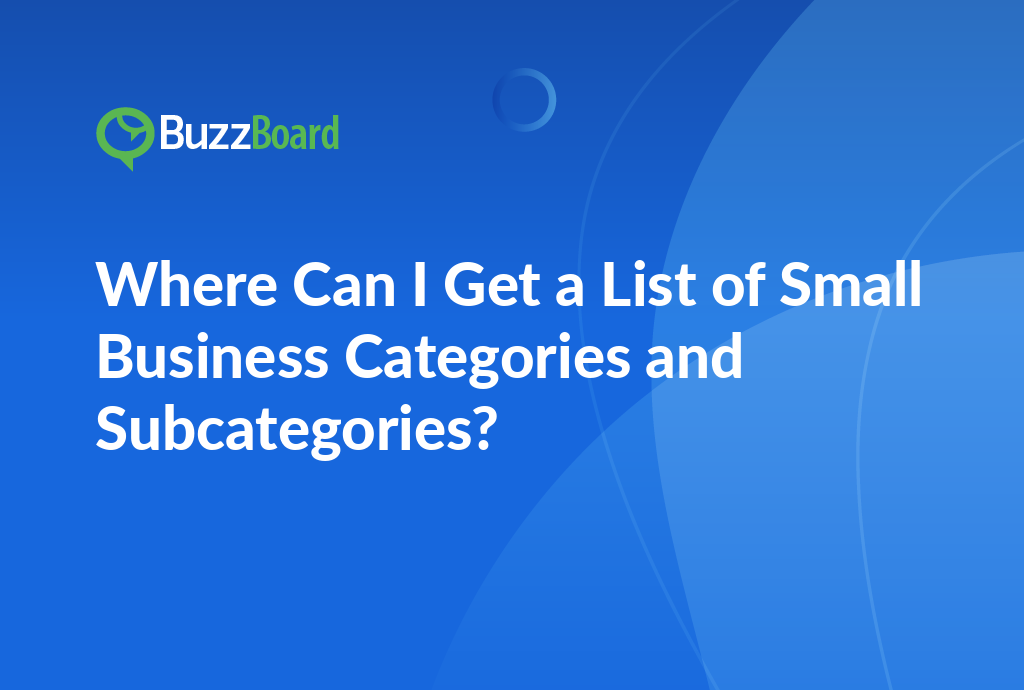Looking for a comprehensive list of small business categories and subcategories? Look no further! This article provides a detailed breakdown of various industries and niches, including retail, food and beverage, healthcare, and more. Get instant access to a categorized list of small business ideas, including subcategories like e-commerce, online services, and local businesses. Whether you’re an entrepreneur, small business owner, or market researcher, this list is a valuable resource to help you identify opportunities and stay ahead of the competition.
Why It Is Essential for Digital Marketing Agencies to Be Aware of Different Small Business Categories and Their Subcategories?
Understanding the intricacies of various small business categories and their subcategories is not just a good-to-have knowledge for digital marketing agencies. It’s an essential know-how. This understanding allows agencies to tailor and customize their approach and service offerings, enabling them to effectively penetrate and succeed in the small business market.
A detailed knowledge base about the list of small businesses and understanding their categories and subcategories allows digital marketing agencies to build efficient and effective strategies. For instance, a local bakery has different objectives and requirements from a tech startup or a manufacturing unit. Every small business, each falling under various categories and subcategories, essentially needs a unique set of digital marketing strategies.
Developing effective marketing strategies for small businesses requires a deep understanding of the unique needs and objectives of each industry and business. In the service industry, for instance, marketing efforts may focus more on reputation management, customer experience, and online reviews, as these factors have a direct impact on the business’s ability to attract and retain customers. On the other hand, retail businesses may require a robust e-commerce strategy to stay competitive and reach a wider audience.
The key to success lies in understanding the operations, objectives, and unique needs of different small businesses. This requires a comprehensive analysis of the business’s strengths, weaknesses, opportunities, and threats (SWOT analysis), as well as an examination of the industry trends, market conditions, and target audience. By gaining a deeper understanding of the business’s pain points and challenges, a digital marketing agency can develop targeted marketing strategies that address these specific needs and offer effective solutions.
For digital marketing firms, this means going beyond a one-size-fits-all approach and instead, developing customized services that resonate with potential clients. This can be achieved by conducting thorough research on various small businesses, their taxonomy, and their unique needs. Exploring different business directories and pulling out a comprehensive list of small business categories and subcategories can provide valuable insights into the diverse range of industries and businesses that exist.
A well-executed analysis based on these insights will prepare your agency to extend customized services that speak directly to the needs of individual businesses. By leveraging your knowledge of small businesses, you can develop marketing strategies that communicate effectively with potential clients and strike the right chords with their target audience.
In today’s competitive landscape, small businesses are looking for agencies that understand their specific needs and can develop marketing strategies that resonate with their target audience. By speaking their language and addressing their unique pain points, your digital marketing firm can differentiate itself from competitors and establish a strong reputation in the industry.
To achieve this, it’s essential to explore the world of small businesses, understand their nuances, and develop marketing strategies that are tailored to their specific needs. By doing so, your services will essentially sell themselves, and you’ll be well on your way to building a loyal client base and establishing your agency as a trusted partner for small businesses.
Some key takeaways for digital marketing firms include:
- Conduct thorough research on various small businesses, their taxonomy, and their unique needs
- Develop customized services that resonate with potential clients
- Leverage your knowledge of small businesses to develop marketing strategies that communicate effectively with potential clients
- Explore different business directories to pull out a comprehensive list of small business categories and subcategories
- Develop targeted marketing strategies that address the specific pain points and challenges of individual businesses
- Establish a strong reputation in the industry by speaking the language of small businesses and addressing their unique needs.
By following these best practices, digital marketing firms can develop effective marketing strategies that help small businesses thrive in today’s competitive landscape.
What Are the Key Benefits to Companies in Understanding a Comprehensive List of Small Business Categories and Subcategories?
One of the most significant advantages of familiarizing yourself with a comprehensive list of small business categories and subcategories is the enhanced capacity to customize your marketing and sales strategies. Small businesses across various industries and sectors have distinct needs, aspirations, and challenges that require tailored approaches to effectively resonate with potential clients. By understanding these specificities, you can modify your approach to better align with the unique requirements of each industry, leading to higher conversion rates, increased engagement, and a stronger sense of trust among potential customers.
Moreover, having a grasp of a specific industry or trade can be instrumental in staying ahead of the curve with the latest trends, consumer behaviors, and market demands. This knowledge enables you to anticipate and adapt to changes in the market, allowing you to stay competitive and responsive to the evolving needs of your clients.
In addition, employing a list of small business categories and subcategories can be a valuable tool in tracking your success in engaging particular sectors. By monitoring which types of businesses respond most positively to your digital marketing efforts, you can gain invaluable insights into your strengths and weaknesses, and finetune your sales tactics accordingly. This continuous improvement enables you to refine your strategies, optimize your results, and ultimately drive greater success.
In today’s business landscape, where access to critical information is paramount, having dependable resources is essential. Websites providing comprehensive lists of small businesses, their categories, and subcategories are invaluable assets for any digital marketing agency. The North American Industry Classification System (NAICS Code) website, for example, offers a complete list of small businesses worldwide, providing a valuable resource for agencies seeking to better understand their target market.
Cracking the tough market of selling digital marketing services to small businesses requires a deep understanding of their unique needs and challenges. An elementary yet profound comprehension of small business categories and subcategories can be the master key to unlocking these markets. By recognizing the distinct characteristics of each industry, you can develop targeted marketing strategies that speak directly to the needs and concerns of each sector, increasing your chances of success.
Furthermore, having a comprehensive understanding of small business categories and subcategories can also help you to identify potential opportunities and threats in the market. By staying informed about the latest trends, consumer behaviors, and market demands, you can anticipate and adapt to changes in the market, allowing you to stay ahead of the competition and capitalize on emerging opportunities.
Familiarizing yourself with a comprehensive list of small business categories and subcategories is a crucial step in developing effective marketing and sales strategies for small businesses. By understanding the unique needs and challenges of each industry, you can tailor your approach to resonate with potential clients, stay ahead of the curve with the latest trends, and drive greater success in the market.
Key Resources and Databases That Can Provide a Structured List of Small Business Categories and Subcategories
Digital marketing agencies must employ innovative strategies to effectively attract and engage with small businesses. One crucial approach is to develop personalized marketing approaches tailored to specific business types and industries. To achieve this, digital marketing professionals must possess a deep understanding of the various categories and subcategories of small businesses.
However, creating an exhaustive list of small business categories and subcategories can be a daunting task. Fortunately, there are numerous helpful resources and databases available that can aid digital marketing professionals in obtaining this vital information. By leveraging these resources, agencies can gain a comprehensive understanding of the diverse range of small businesses and develop targeted marketing strategies that resonate with each unique category.
One valuable resource is the United States Small Business Administration (SBA), which provides a wealth of data, including categories and subcategories of businesses. The SBA’s NAICS (North American Industry Classification System) codes offer a comprehensive list of small business categories and subcategories, organized by sector. This includes industries such as agriculture, mining, construction, manufacturing, and many others. By consulting the SBA’s NAICS codes, digital marketing agencies can gain a deeper understanding of the various business categories and develop targeted marketing strategies that cater to specific industries.
Another significant resource is ReferenceUSA, a leading provider of business and residential information for study and research. This database is unique in its approach to categorizing businesses into suitable categories and subcategories, offering an organized framework for identifying potential clients. By utilizing ReferenceUSA, digital marketing agencies can gain access to a vast array of business data, including industry-specific information, company profiles, and contact details.
Data.gov, a platform that provides a vast array of data sets covering a broad range of small business types, is another valuable resource for digital marketing agencies. This platform offers a wealth of information on small businesses, including industry-specific data, company profiles, and market trends. By leveraging Data.gov, agencies can gain a deeper understanding of the diverse range of small businesses and develop targeted marketing strategies that cater to specific industries.
By understanding the finer categorization of small businesses, digital marketing agencies can develop accurate strategies that address the unique needs of each category. This includes creating targeted value propositions that resonate with specific business types, enhancing the chances of a successful sale. Moreover, by leveraging these resources, agencies can gain a competitive edge in the market, differentiate themselves from competitors, and establish themselves as experts in their field.
Understanding the various categories and subcategories of small businesses is a crucial step in developing effective marketing strategies. By leveraging resources such as the SBA, ReferenceUSA, and Data.gov, digital marketing agencies can gain a comprehensive understanding of the diverse range of small businesses and develop targeted marketing approaches that cater to specific industries. By doing so, agencies can increase their chances of success, establish themselves as experts in their field, and build strong relationships with their clients.
How Understanding Small Business Categories and Subcategories Can Help Digital Marketing Firms to Target Their Campaigns Better?
Small businesses have become increasingly diverse and dynamic. As a result, digital marketing firms must be equipped with a deep understanding of the various small business categories and subcategories to effectively deliver outstanding services and stand out in a crowded market. By grasping the nuances of these categories, digital marketing firms can create more targeted and precise marketing campaigns, ultimately leading to improved return on investment and stronger client relationships.
The list of small business categories and subcategories is a reflection of the dynamic and constantly shifting marketplace. By understanding these categories, digital marketing firms can reap significant benefits, including reduced marketing expenses and enhanced client relationships. This knowledge enables firms to refine their marketing strategies, ensuring that they always hit the mark and reach the right target audience.
For instance, a pay-per-click (PPC) campaign for a small luxury jewelry business requires a distinct approach compared to a fast-food restaurant in the hospitality sector. A deeper understanding of a client’s business allows for a more direct and tailored strategy in marketing efforts, leading to increased sales leads and customer satisfaction. By recognizing the unique characteristics and needs of each business category and subcategory, digital marketing firms can develop targeted marketing campaigns that resonate with their clients’ target audiences.
Moreover, a comprehensive understanding of small business categories and subcategories enables digital marketing firms to leverage analytics to gain insights into customer behavior. By analyzing data and tracking customer interactions, firms can identify trends, preferences, and pain points, allowing them to refine their marketing strategies and optimize their campaigns for maximum impact. This data-driven approach keeps digital marketing firms ahead of the competition and drives conversions.
Furthermore, comprehension of clients’ business categories and subcategories is essential for aligning digital marketing services with their specific needs. For example, a small carpentry business in the artisan goods subcategory requires a distinct digital marketing approach compared to a tech-based business in the online retail subcategory, even though both fall under the selling goods category. By understanding the unique characteristics and requirements of each business category and subcategory, digital marketing firms can develop customized solutions that meet the specific needs of their clients.
Mstering the list of small business categories and subcategories should be a top priority for digital marketing firms. This knowledge not only catalyzes the success of clients but also promotes business growth and differentiation. By staying up-to-date with the latest trends and developments in small business categories and subcategories, digital marketing firms can establish themselves as thought leaders in their industry, build strong relationships with clients, and drive business results.
Expert Tips on Effective Usage of Small Business Category and Subcategory Lists for Planning Advertising Strategies
You may wonder, how does this list of small business categories and subcategories fit in your current marketing strategy? Let’s elaborate.
Remember, the aim of any advertising strategy is to make sure your content connects with the audience – the better the fit, the higher the engagement. A list of small business categories and subcategories can be your compass, guiding you to potential clients and ensuring your painstakingly crafted campaigns hit the mark.
Conclusion
In conclusion, finding the right small business category and subcategory can be a crucial step in launching a successful venture. By understanding the various industries and niches, you can identify opportunities that align with your skills, interests, and resources. The list of small business categories and subcategories provided in this article is a valuable resource for entrepreneurs, small business owners, and market researchers alike.
Whether you’re looking to start a new business, expand your existing operations, or simply stay ahead of the competition, this list can help you make informed decisions. Remember to consider factors such as market demand, competition, and growth potential when selecting a category and subcategory.
By leveraging this list and doing your due diligence, you can increase your chances of success and build a thriving small business that meets the needs of your customers and stakeholders. So, what are you waiting for? Start exploring the list of small business categories and subcategories today and take the first step towards achieving your entrepreneurial goals!”
This conclusion aims to summarize the main points of the article, reiterate the importance of finding the right category and subcategory, and encourage readers to take action. It also provides a final call-to-action, urging readers to start exploring the list and taking the first step towards achieving their entrepreneurial goals.









